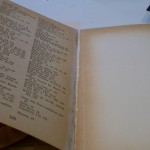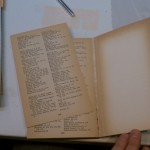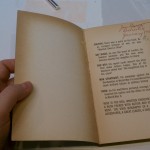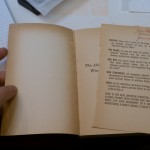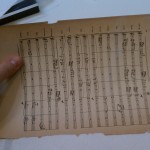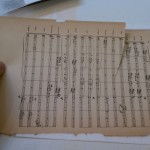Over the weekend I took another class up at the SFCB — this time on basic paper mending. It was really interesting to learn a few methods of cleaning and repairing mangled pages. We also learned how to reattach pages that had fallen out of a trade paperback.
One theme that the teacher kept coming back to was considering whether you’d be doing more harm than good by trying to repair the object in question. For example, if you’re trying to mend a document that has water-soluble ink on it, the chances of the paste making the ink run are very high (we learned how to test for water-solubility while minimizing the chance of damage to the object, which was cool). Plus, even the best mend is visible – creases and tears can’t be completely eliminated, just minimized. Reattached pages usually involve a hinge of some sort, which is visible. It’s just not possible to make the object exactly what it was before. There are always trade-offs. You have to consider why you want to mend the item — are you trying to make it usable again? Trying to make it look nicer?
We used high-quality wheat starch paste and a variety of thicknesses of Japanese paper to mend tears and cuts, and learned to fill in spots where a tear had left a hole. We also learned how to uncrumple paper with the least amount of damage to it. It was a rather slow class in the beginning but the afternoon was really interesting and I had a good time.
The teacher works at UC Berkeley doing restoration/conservation on materials in the university’s library system, and she said that often the best course of action is to try to stabilize the item rather than try to make it be just like it used to be. Old books that are falling apart can be stored in specially-made boxes, documents can be sealed into mylar sleeves, and so on.
One thing that complicates the decision-making process is that book conservation is relatively new — less than 100 years old — so it’s not entirely possible to know how your additions will change over time. Apparently a lot of mending techniques that were considered safe in the fifties are now causing damage as they age. Chemicals in the adhesives, mending materials, and the objects themselves can react in surprising ways, given enough time.
At any rate, it was really interesting and I had a great time. Plus, I learned how to make the kind of wheat paste that requires cooking! I’ve ordered the materials to make a batch of my own and will let you guys know how it goes!
Here are some images from the class:
